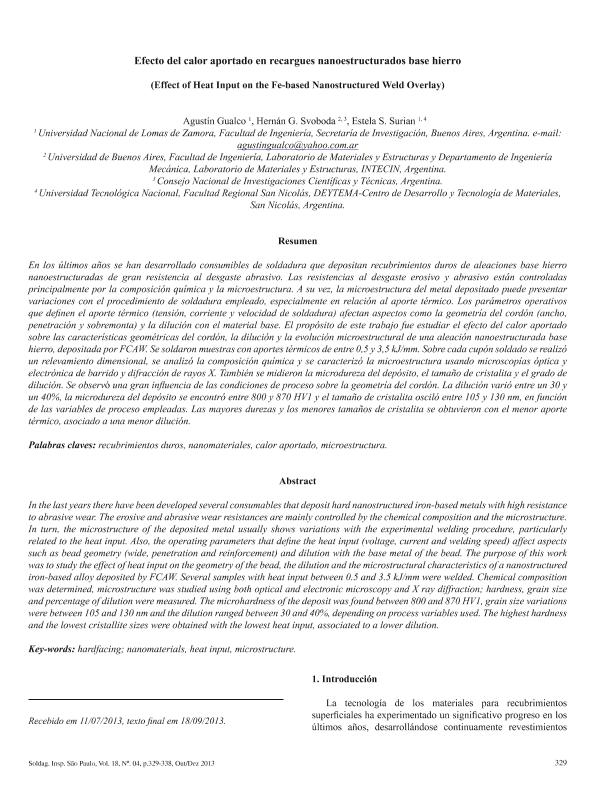Artículo
En los últimos años se han desarrollado consumibles de soldadura que depositan recubrimientos duros de aleaciones base hierro nanoestructuradas de gran resistencia al desgaste abrasivo. Las resistencias al desgaste erosivo y abrasivo están controladas principalmente por la composición química y la microestructura. A su vez, la microestructura del metal depositado puede presentar variaciones con el procedimiento de soldadura empleado, especialmente en relación al aporte térmico. Los parámetros operativos que definen el aporte térmico (tensión, corriente y velocidad de soldadura) afectan aspectos como la geometría del cordón (ancho, penetración y sobremonta) y la dilución con el material base. El propósito de este trabajo fue estudiar el efecto del calor aportado sobre las características geométricas del cordón, la dilución y la evolución microestructural de una aleación nanoestructurada base hierro, depositada por FCAW. Se soldaron muestras con aportes térmicos de entre 0,5 y 3,5 kJ/mm. Sobre cada cupón soldado se realizó un relevamiento dimensional, se analizó la composición química y se caracterizó la microestructura usando microscopías óptica y electrónica de barrido y difracción de rayos X. También se midieron la microdureza del depósito, el tamaño de cristalita y el grado de dilución. Se observó una gran influencia de las condiciones de proceso sobre la geometría del cordón. La dilución varió entre un 30 y un 40%, la microdureza del depósito se encontró entre 800 y 870 HV1 y el tamaño de cristalita osciló entre 105 y 130 nm, en función de las variables de proceso empleadas. Las mayores durezas y los menores tamaños de cristalita se obtuvieron con el menor aporte térmico, asociado a una menor dilución. In the last years there have been developed several consumables that deposit hard nanostructured iron-based metals with high resistance to abrasive wear. The erosive and abrasive wear resistances are mainly controlled by the chemical composition and the microstructure. In turn, the microstructure of the deposited metal usually shows variations with the experimental welding procedure, particularly related to the heat input. Also, the operating parameters that define the heat input (voltage, current and welding speed) affect aspects such as bead geometry (wide, penetration and reinforcement) and dilution with the base metal of the bead. The purpose of this work was to study the effect of heat input on the geometry of the bead, the dilution and the microstructural characteristics of a nanostructured iron-based alloy deposited by FCAW. Several samples with heat input between 0.5 and 3.5 kJ/mm were welded. Chemical composition was determined, microstructure was studied using both optical and electronic microscopy and X ray diffraction; hardness, grain size and percentage of dilution were measured. The microhardness of the deposit was found between 800 and 870 HV1, grain size variations were between 105 and 130 nm and the dilution ranged between 30 and 40%, depending on process variables used. The highest hardness and the lowest cristallite sizes were obtained with the lowest heat input, associated to a lower dilution.
Efecto del calor aportado en recargues nanoestructurados base hierro
Título:
Effect of Heat Input on the Fe-based Nanostructured Weld Overlay
Fecha de publicación:
10/2014
Editorial:
Assoc Brasil Soldagem
Revista:
Soldagem & Inspeção
ISSN:
0104-9224
e-ISSN:
1980-6973
Idioma:
Español
Tipo de recurso:
Artículo publicado
Clasificación temática:
Resumen
Palabras clave:
Recubrimientos Duros
,
Nanomateriales
,
Aporte Térmico
,
Microestructura
Archivos asociados
Licencia
Identificadores
Colecciones
Articulos(INTECIN)
Articulos de INST.D/TEC.Y CS.DE LA ING."HILARIO FERNANDEZ LONG"
Articulos de INST.D/TEC.Y CS.DE LA ING."HILARIO FERNANDEZ LONG"
Citación
Gualco, Agustin; Svoboda, Hernán Gabriel; Surian, Estela S.; Efecto del calor aportado en recargues nanoestructurados base hierro; Assoc Brasil Soldagem; Soldagem & Inspeção; 18; 4; 10-2014; 329-338
Compartir
Altmétricas




